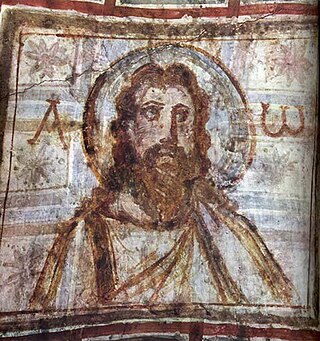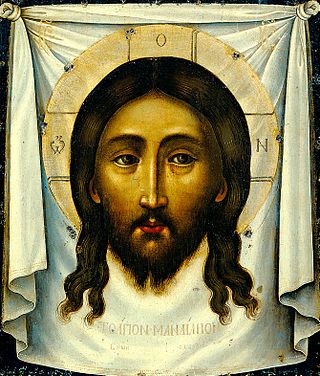This is a list of hoaxes related to religion.
This is a list of hoaxes related to religion.

Pseudo-Dionysius the Areopagite was a Greek author, Christian theologian and Neoplatonic philosopher of the late 5th to early 6th century, who wrote a set of works known as the Corpus Areopagiticum or Corpus Dionysiacum.

The depiction of Jesus in pictorial form dates back to early Christian art and architecture, as aniconism in Christianity was rejected within the ante-Nicene period. It took several centuries to reach a conventional standardized form for his physical appearance, which has subsequently remained largely stable since that time. Most images of Jesus have in common a number of traits which are now almost universally associated with Jesus, although variants are seen.

Denis of Paris was a 3rd-century Christian martyr and saint. According to his hagiographies, he was bishop of Paris in the third century and, together with his companions Rusticus and Eleutherius, was martyred for his faith by decapitation. Some accounts placed this during Domitian's persecution and incorrectly identified St Denis of Paris with the Areopagite who was converted by Paul the Apostle and who served as the first bishop of Athens. Assuming Denis's historicity, it is now considered more likely that he suffered under the persecution of the emperor Decius shortly after AD 250.

The Dormition of the Mother of God is a Great Feast of the Eastern Orthodox, Oriental Orthodox, and Eastern Catholic Churches. It celebrates the "falling asleep" (death) of Mary the Theotokos, and her being taken up into heaven. It is celebrated on 15 August as the Feast of the Dormition of the Mother of God. The Armenian Apostolic Church celebrates the Dormition not on a fixed date, but on the Sunday nearest 15 August. In Western Churches the corresponding feast is known as the Assumption of Mary, with the exception of the Scottish Episcopal Church, which has traditionally celebrated the Falling Asleep of the Blessed Virgin Mary on 15 August.
A number of alleged relics associated with Jesus have been displayed throughout the history of Christianity. While some individuals believe in the authenticity of Jesus relics, others doubt their validity. For instance, the sixteenth-century philosopher Erasmus wrote about the proliferation of relics, and the number of buildings that could be constructed from wooden relics claimed to be from the crucifixion cross of Jesus. Similarly, at least thirty Holy Nails were venerated as relics across Europe in the early 20th century. Part of the relics are included in the so-called Arma Christi, or the Instruments of the Passion.

Pseudepigrapha are falsely attributed works, texts whose claimed author is not the true author, or a work whose real author attributed it to a figure of the past. The name of the author to whom the work is falsely attributed is often prefixed with the particle "pseudo-", such as for example "pseudo-Aristotle" or "pseudo-Dionysius": these terms refer to the anonymous authors of works falsely attributed to Aristotle and Dionysius the Areopagite, respectively.
The Shroud of Turin, also known as the Holy Shroud, is a length of linen cloth that bears a faint image of the front and back of a man. It has been venerated for centuries, especially by members of the Catholic Church, as the actual burial shroud used to wrap the body of Jesus of Nazareth after his crucifixion, and upon which Jesus's bodily image is miraculously imprinted. The human image on the shroud can be discerned more clearly in a black and white photographic negative than in its natural sepia color, an effect discovered in 1898 by Secondo Pia, who produced the first photographs of the shroud. This negative image is associated with a popular Catholic devotion to the Holy Face of Jesus. The shroud's authenticity as a holy relic has been disputed even within the Catholic Church, and radiocarbon dating has shown it to be a medieval artifact.

The New Testament apocrypha are a number of writings by early Christians that give accounts of Jesus and his teachings, the nature of God, or the teachings of his apostles and of their lives. Some of these writings were cited as scripture by early Christians, but since the fifth century a widespread consensus has emerged limiting the New Testament to the 27 books of the modern canon. Roman Catholic, Eastern Orthodox, and Protestant churches generally do not view the New Testament apocrypha as part of the Bible.
The Gelasian Decree is a Latin text traditionally thought to be a Decretal of the prolific Pope Gelasius I, bishop of Rome from 492–496. The work reached its final form in a five-chapter text written by an anonymous scholar between 519 and 553, the second chapter of which is a list of books of Scripture presented as having been made part of the biblical canon by a Council of Rome under Pope Damasus I, the bishop of Rome from 366–383. This list is known as the Damasine List. The fifth chapter of the work includes a list of distrusted and rejected works not encouraged for church use.
Modern pseudepigrapha, or modern apocrypha, refer to pseudepigrapha of recent origin – any book written in the style of the books of the Bible or other religious scriptures, and claiming to be of similar age, but written in a much later (modern) period. They differ from apocrypha, which are books from or shortly after the scriptural period but not accepted into the religion's canon. Exposing modern pseudepigrapha is part of the fields of palaeography and papyrology, amongst others.

Acheiropoieta — also called icons made without hands — are Christian icons which are said to have come into existence miraculously; not created by a human. Invariably these are images of Jesus or the Virgin Mary. The most notable examples that are credited by tradition among the faithful are, in the Eastern church, the Mandylion, also known as the Image of Edessa, and the Hodegetria, and several Russian icons, and in the West the Shroud of Turin, Veil of Veronica, Our Lady of Guadalupe, and the Manoppello Image. The term is also used of icons that are only regarded as normal human copies of a miraculously created original archetype.

The Holy Face of Jesus is a title for specific images which some Catholics believe to be miraculously formed representations of the face of Jesus Christ. The image obtained from the Shroud of Turin is associated with a specific medal worn by some Roman Catholics and is also one of the Catholic devotions to Christ.
The unknown years of Jesus generally refers to the period of Jesus's life between his childhood and the beginning of his ministry, a period not described in the New Testament.

The following outline is provided as an overview of and topical guide to Christianity:
Holger Kersten is a German writer on myth, legend, religion, and esoteric subjects. He is best known for speculative books about time Jesus spent in India. Kersten's views have received no support from mainstream scholarship.

Saint Peter, also known as Peter the Apostle, Simon Peter, Simeon, Simon, or Cephas, was one of the Twelve Apostles of Jesus Christ and one of the first leaders of the early Christian Church. He appears repeatedly and prominently in all four New Testament gospels as well as the Acts of the Apostles. Catholic and Orthodox tradition accredits Peter as the first bishop of Rome—or pope—and also as the first bishop of Antioch.
Articles related to Christianity include:

The Acts of Thaddeus is a Greek document written between 544 and 944 CE which purports to describe correspondence between King Abgar V of Edessa and Jesus, which results in Jesus' disciple Thaddeus going to Edessa.